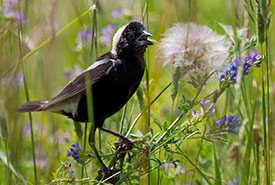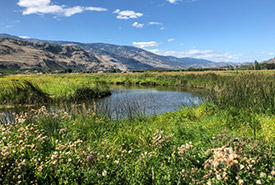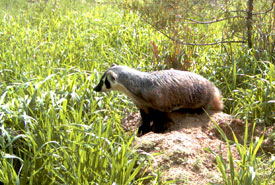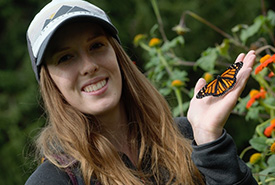World Wildlife Day: Restoration to support species at risk recovery

Bobolink, Prairie Smoke Nature Reserve, Carden Alvar, ON (Photo by NCC)
I’m a casual birder. I like to take my binoculars with me when I’m out in nature, but I’m not usually one to go out chasing after rare birds. Still, there is one species that I can’t believe I haven’t seen before: bobolink. Males have unmistakable plumage — all black with a yellow patch on the back of the head — and a recognizable song. You can’t miss them!
Prior to joining the Nature Conservancy of Canada (NCC), I worked for two whole summers in agricultural fields, one summer in southern Alberta, and one in southern Ontario. With nearby hayfields and meadows, these are perfect areas to spot or hear a bobolink, but no luck. Perhaps I was so engrossed in my work I just didn’t notice. Or perhaps it’s because bobolinks have declined by 88 per cent in the past 40 years and they just aren’t around for me to spot, even if they are distributed across southern Canada.
Bobolinks are threatened in Canada. They originally nested in native prairie, but most of that was cleared for agricultural use. Now, they don’t have much native habitat left to rely on and use hayfields, pastures and meadows. Unfortunately, modern agricultural operations are often not compatible with a bird that nests on the ground in open fields. But the good news is, we can restore habitat for this species.

Osoyoos Oxbows post-restoration in 2019 (Photo by NCC)
In Ontario, NCC is restoring native grassland and savannah habitat in Rice Lake Plains for this species. In BC, we’ve even named the Bobolink Meadows Conservation Area in the Okanagan Valley after the species.
World Wildlife Day
This World Wildlife Day (March 3), we are celebrating the recovery of key species for ecosystem restoration. Canada has over 804 species at risk, as designated by the Committee on the Status of Endangered Wildlife in Canada. It’s certainly daunting to think about how much we must restore to provide enough suitable habitat for these vulnerable species. But NCC is accelerating the pace of conservation (and restoration) in Canada, leading to a positive impact on the plants and animals that rely on once-lost habitat across the country. It’s also the UN Decade on Ecosystem Restoration, reminding us we are not alone in mobilizing to restore critical habitat. The world is with us.

American badger at Columbia Lake-Lot 48. (Photo by NCC)
There are many species at risk aside from bobolink that we are restoring critical habitat for at NCC. In BC, we are thinning forests that are encroaching on grassland habitat to bring back patches of open grassland, which benefits endangered American badgers. In Alberta, we are restoring a large agricultural field to native prairie grassland for endangered greater sage-grouse and other grassland species. Habitat restoration in Saskatchewan benefits northern leopard frogs, a species of special concern across the Prairies. The endangered western prairie white-fringed orchid benefits from tall grass prairie restoration in Manitoba. In Quebec, we’re restoring wetlands to support several species of at-risk turtles. Forest restoration in Atlantic Canada benefits several species at risk, from plants to mammals to birds. By creating habitat for these species to thrive they, in turn, will support a diverse and functional ecosystem.
I’m confident that our collective efforts to restore habitat for vulnerable populations will result in fewer plants and animals at risk. Hopefully, it will result in additional bobolinks on the landscape and perhaps one day they will be abundant enough that I not only see my first bobolink, but I see them regularly.


